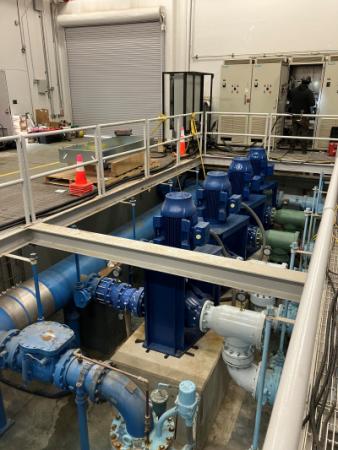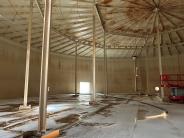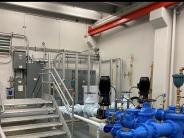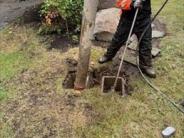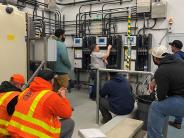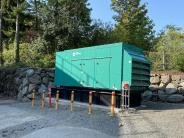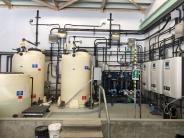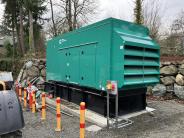City Completes Generational Upgrades to Water System
The City of Mercer Island recently wrapped up a four-year effort to modernize its water storage and distribution system. This work, carried out through a series of coordinated projects, has greatly improved resilience and reliability, ensuring high quality water service for Island residents and businesses.
The initiative was launched in response to a 2014 E. coli contamination incident and subsequent Department of Health recommendations that called for system-wide improvements. The City undertook multiple projects that together addressed key areas of infrastructure: replacing and upgrading critical water pump and monitoring systems; installing a new diesel generator and associated electrical infrastructure to ensure reliable backup power; recoating the City’s two 4-million-gallon water reservoirs while also adding new safety features; constructing a chlorination booster station to safeguard water quality and improve circulation; replaced the control systems for the water and sewer utilities; and implemented a new water metering program, including the replacement of more than 7,000 meters with smart meters.
“Much of Mercer Island’s water infrastructure dates back several decades,” said Jason Kintner, Chief of Operations for the City’s Public Works Department. “This generational investment greatly reduces the risk of major service disruptions and improves resiliency.”
Because of Mercer Island’s hilly terrain and elevation changes, pumps are required to move water to homes, businesses, and public facilities. The City’s original pumps, installed in the 1970s, had begun to fail. At the time of replacement, only two of the five were fully operational, and peak demand was straining them. The new system includes five high-capacity pumps and two smaller auxiliary pumps. Under normal conditions, the auxiliary pumps can handle daily demand, extending the lifespan of the larger pumps and conserving energy. During summer months and peak periods such as mornings and evenings, up to three large pumps are used, with the remaining two pumps kept in reserve to ensure fire flow capacity and uninterrupted service.
To support the new pumps, the City replaced its underpowered emergency generator with a larger and cleaner burning unit capable of running the entire system, including the emergency well, during outages. The accompanying electrical upgrades not only support the generator but also provide greater flexibility for future needs.
The City maintains two reservoirs, each holding 4 million gallons, to ensure adequate supply during high-demand periods. Both tanks were recoated inside and outside as part of the project to prevent corrosion and preserve water quality. The new coatings are expected to last at least 25 years. Safety enhancements, including new staircases and railings, were installed to make routine inspections and maintenance safer for staff.
Following the 2014 contamination incident, the City developed a Coliform Response Action Plan, which identified construction of a chlorination booster station as a top priority. The new facility ensures chlorine levels remain at—or can be raised to—Department of Health standards once water enters the Island from Seattle Public Utilities. New mixer units circulate water within the reservoirs, ensuring consistent chlorine distribution.
The City's sewer and water utilities are each monitored and controlled remotely by a system called Supervisory Control and Data Acquisition (SCADA). The City relies on the SCADA system for control and alarm notifications, and it is important that this system operates with the highest reliability to protect the environment while providing safe and reliable drinking water and community sewer services.
In 2017, the City learned that critical components of its SCADA system were faltering. Frequent alarms, fragmented SCADA components, and loss of reliability within the system prompted an internal evaluation and planning process for replacement. Design and programming work for the SCADA system replacement began in March 2019 and the Water Utility SCADA system was completed in 2022. The Sewer Utility SCADA replacement was more complex, requiring additional design. The Sewer Utility SCADA system was completed in May 2025.
In 2022, the City Council approved the Water Meter Replacement project to replace all water meters on Mercer Island with an Advanced Metering Infrastructure (AMI) system. In addition to new smart meters, the AMI system uses data collection stations to securely transmit water usage data from each meter to the City’s utility billing software. This advanced technology provides precise, hourly water use data that helps support conservation activities with improved leak detection and allows staff to focus on addressing water issues.
Between April and November of 2024, all City water meters were replaced with smart meters. The City is in the process of installing the last two data collection stations, which will enable the AMI system to collect data from every meter on Mercer Island. A customer portal will be launched in January 2026 which will allow residents to view their own water use data and receive alerts and notifications.
These projects represent some of the most significant investments in Mercer Island’s water system in decades. By strengthening infrastructure, adding new safeguards, and planning for future needs, the City has ensured that residents and businesses will benefit from a safer, more reliable, and more resilient water supply for decades to come.

